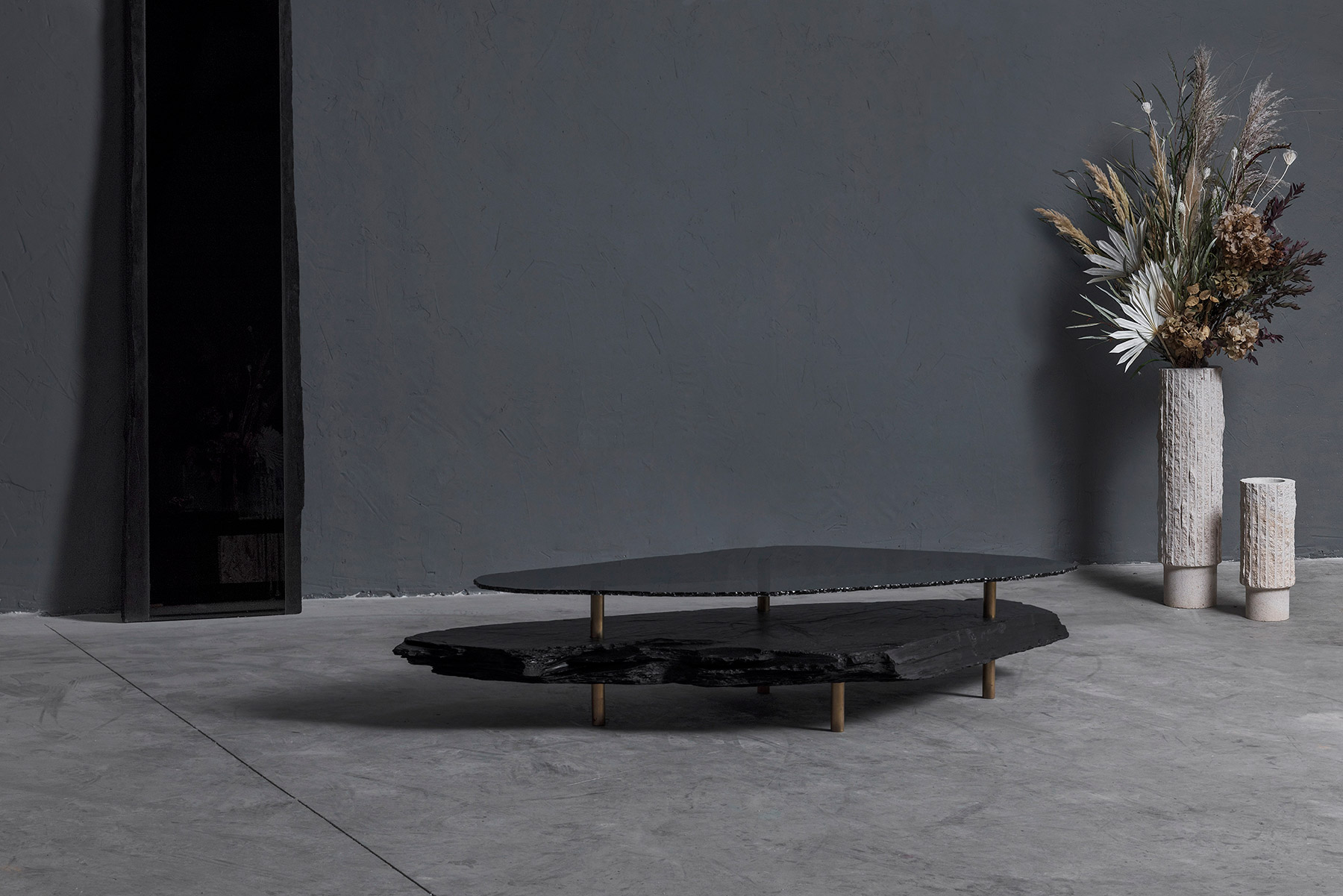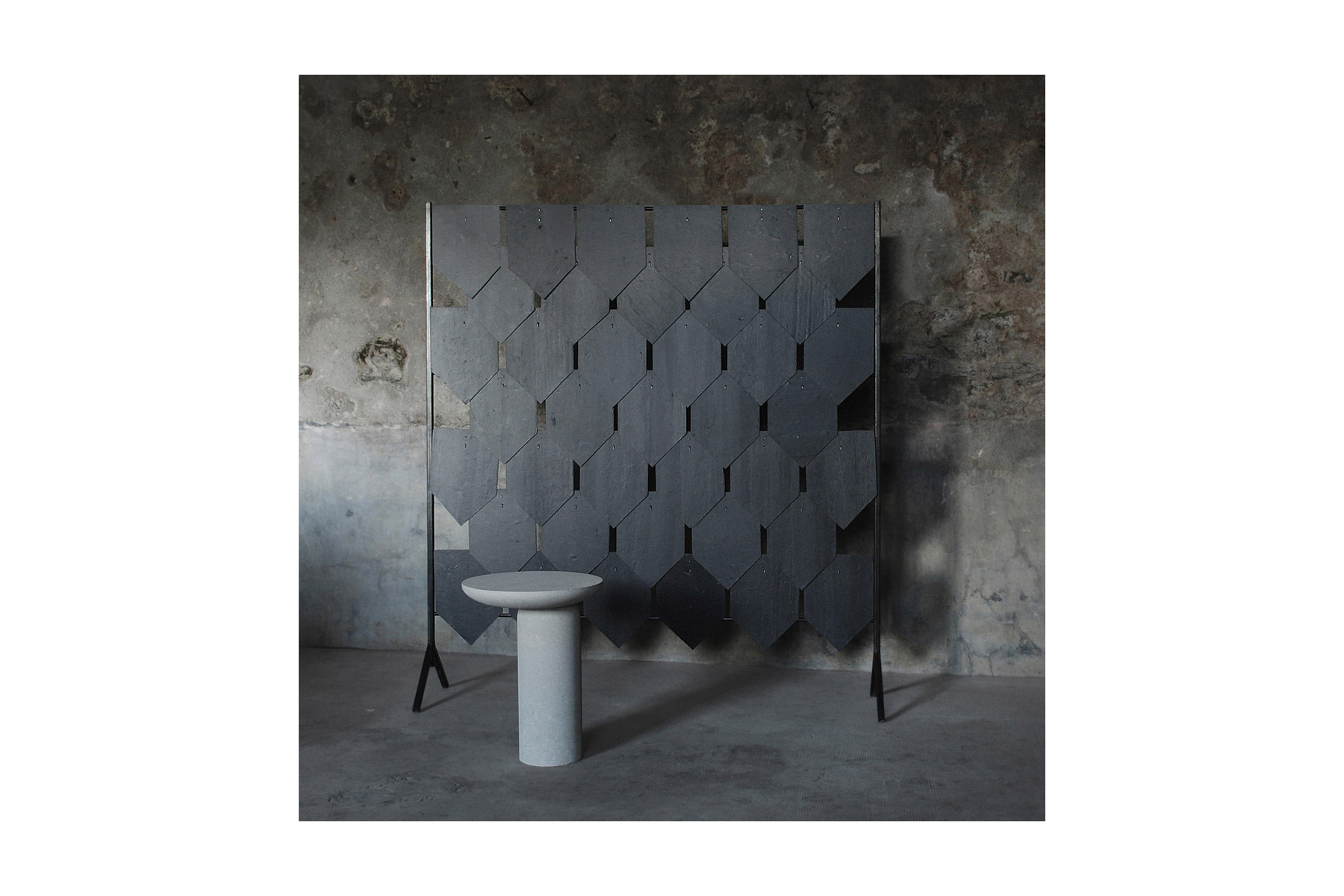Originally from Anjou, I examine the post-industrial heritage of local mineral matter and explore the realm of possibilities of creating functional designs for living spaces. I do this by examining history, minerals and their everyday impact on art and design. I recreate, democratise and accentuate slate and limestone as future heritages and, above all, as materials to reflect on. I am passionate about combining artisanal and industrial know-how for creative purposes, reinterpreting material in a formal and conceptual manner with the aim of reevaluating it on another scale – that of contemporary design.
Domestiquer (Domesticate) is a project that aims to reintegrate heritage with the author’s design process, fuelled by encounters of creative and economic thought with partners and collaborators.
Frédéric Saulou explore and combine the industrial and artisanal units of production in a given region in order to design a constructive, social and meaningful project. This gives rise to new ways of applying mineral matter and stone craftsmanship, which are constantly evolving. Through my work, I study the adaptability of hybrid objects to the domestic world fuelled by transmitting thoughts and knowledge.
The means of artisanal and industrial production inexorably influence form and are the technical and aesthetic extension of the shaping of the object, a reflection of a mastered and successful piece of work that must last and adapt over time. From there, all the pieces strive towards a fair, mastered, simple and striking design, giving pride of place to raw materials and tools. In this way I combine the tools of production and create parallels between the arts and the digital dimension. The result is the equation of techniques and constraints to strive for a volume created at two speeds but simultaneously, allowing for the projection of volumes to be interpreted in two ways.
The use of traditional materials is no coincidence. In the past, and still today, these materials have proved their worth and are firmly present in history. However, as time goes by and materials and know-how multiply, these minerals sometimes considered as “poor” become dated and I try to evoke the origin of their use. As they were the basis of modern home designs dating from a certain era, I like to modestly pay homage to that era by reinventing them and giving them a new function. By redesigning their original function, they become objects and are included in domestic spaces.Architectural references are part of this archeological work which creates a mise en abîme of the heritage of symbols of construction in symbiosis with the codes of modern works.
The ensemble therefore creates a strong identity at the crossroads of modern objects and historical roots. The result is a mastered, simple and raw aesthetic, controlled but also naturally freed. The creations are made from natural resources, some are sometimes transformed by man to form a balance. The inspiration for the creations comes from architectural codes being used as a creative lever.
My work must be timeless, like a lasting, solid construction. Through simple but constructed volumes, the immersion of material in space is pure, as if the object had always been there, as if it were part of the walls.
I prefer a visual, obvious and sometimes primitive style but I find it to be reassuring and striking. The round and decorative forms respond to the straight and pure lines by alluding to the periods of ornamentation to the streamlining of space of the 90s. The tools and lines can be interpreted as the new, modern but elementary, architectural forms, just like monolithic and geometric sculptures. The sparing use of resources is clearly evident in a monumental dimension reflecting the idea of the scale of space where habitat and environment mix.
Schist
Slate is both a brittle and very strong material. It is amazing to be able to chisel lace in a sheet of slate, like shaping a monolithic form in a massive block. This sedimentary rock comes from clay that has undergone metamorphism. It belongs to the schist family that comes from the mineralogical transformation of clays into schists. Difficult to extract in large sizes, the material is carefully chosen and extracted to measure to find the best elements needed to create large-scale artistic objects. Each stone is chosen for its shape, colour and quality.
Slate is very dense compared to other rocks and is distinguished by its fissility because its grains are very fine and homogenous. In its deep and soft black there is a palette of subtle colours. Its appearance is glossy because of the presence of small white mica that sometimes give it this marble-like appearance and allow for different finishes. As for the naturally raw cleaved layers, they express themselves freely with their aesthetic defects and their uncertain graphic aspects. So unique in their nature, they allow for the experimentation of their surfaces.

Frédéric Saulou
Born in 1989, Frédéric Saulou, lives and works in Rennes, in France. Graduated in space and environmental design at the Institut Supérieur des Arts Appliqués (LISAA) in 2011 and in object design at the Ecole Européenne Supérieure des Beaux Arts de Rennes (EESAB) in 2013, Frédéric will continue to perfect his experience within the Eric Gizard Associés agency and with the designer Frédéric Ruyant.
In 2013, he founded the studio – Frédéric Saulou Design Studio – an independent and multidisciplinary design and consulting agency that sees design as a space for research and exchange that allows him to develop a sensitive approach to forms and materials.
Experimentation and research take precedence over his work in order to think of new materials and new uses. This accompanies his daily approach so that each project is conceived as a sculpture in its own right, between simplicity and technicality. His approach guides him towards a global approach but also unique in his creations, thus creating particular interactions between the user and the object, between industrial craftsmanship.
Today Frédéric works on various projects, from objects to space, in series or limited editions and collaborates with prestigious institutions and brands such as the publishing houses Ligne Roset, Drugeot Manufacture, Brossier Saderne, Vista Alegre, Esprit Porcelaine Limoges, Galerie Philia, Galerie Room, Dymant, Haptein, Le Molitor, Suite 13, Dixjours, Savannah Bay Gallery…













